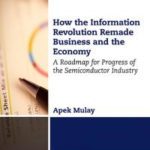“Connect with India” was a very successful event this year at Semicon West. Bettina Weiss (Vice President of Business Development at SEMI) organized this event. Along with several dignitaries from Indian government and its upcoming semiconductor industry, there were several semiconductor industry professionals from India and around the world who attended this event. The new government of India seems very serious about its plans to establish a semiconductor manufacturing facility in India. It was a great networking opportunity with the members of the executive team of Indian semiconductor industry, Absolutely.
Several members of executive team participated in a panel discussion :-
1.Mr. Bharat Gupte, President, HSMC Technologies
2.Mr. M N Vidyashankar, President, IESA
3.Mr. Satish Gupta, President, HSMC Technologies
4.Mr. Russell Ellwanger, CEO, Towerjazz
5.Dr. Ajay Kumar, Joint Secretary, Govt. of India
6.Mr. Deven Verma, Chairman & CEO, HSMC Technologies
7.Mr. Ashok Kumar, CFA, Imperial Capital
8.Dr Krishna Saraswat, Professor, Stanford University
As a macroeconomist of microelectronics industry, I was very pleased to know that India has finally decided to solve the problems of its account deficits which are resulting from its import of electronics. A semiconductor manufacturing facility is very much needed and with the abundant talent of Indian engineers and entrepreneurs, this industry does have the required human resource for growth of fabless businesses within the country. However, The industry has long way to go from the point of view of establishing state-of-the-art facilities in its universities which offer hands-on experience in semiconductor processing to its future work force.
The industry plans to work with ST Microelectronics and license their process to the upcoming fabs. The CEO of Towerjazz is of the opinion to continue using older and matured processes and concentrate on growth of Analog ICs as compared to be at the bleeding edge of digital technology. Hence, I am optimistic that the plans to establish the fab and license the manufacturing process from ST Microelectronics and Towerjazz will succeed. However, there are a few things to worry about from the point of view of sustainability of the semiconductor manufacturing industry.
Firstly, When I posed the question about the rising trade deficits because of free trade policies, I formed the impression that the panel wants India to continue free trade instead of fair trade. I would certainly recommend the panel to read my article “A Failure Analysis of the US Economy” where I have demonstrated the myth about free trade and its contributions to US trade deficits. Hence, First and foremost thing that the executive committee should take care of is to eliminate free trade and establish a fair trade. This is only way for India to keep a check on its account deficits and at the same time ensure that Indian semiconductor manufacturing remains sustainable.
Secondly, India needs to invest heavily in growth of highly skilled analog design engineers if India plans to focus on growth of analog ICs. Indian semiconductor industry also needs to ensure that their fabs are operation 24×7 and there is no idle time for fabs to keep its investments sustainable . The way to achieve the same is to establish a free market economy and have a robust growth of fabless semiconductor industry. India cannot ignore the digital side of technology development as today’s latest and greatest electronics products also have the most advanced ICs. The new generations of smartphones and tablet PCs also have digital ICs along with other mixed signal components.
If Indian semiconductor industry only focuses on the growth of its analog chipsets and ignores the growth of digital ICs, then the electronic products manufactured in India would not be able to compete with their foreign counterparts due to poor quality. They would contribute to poor demand for Indian electronic products. In that case the import of the foreign manufactured goods would continue contributing to its account deficits. Hence, Along with macroeconomic reforms, Indian semiconductor industry needs to have a balanced growth of not just analog but also digital electronics. Therefore, Indian semiconductor manufacturing needs a new roadmap for sustainability of its huge capital investments.
The establishment of fabs is just one thing, there should also be growth of package and assembly facilities, testing facilities, etc. without which the Indian semiconductor industry would remain incomplete. It is a best opportunity for India to revamp its economy and transition from developing to a developed economy with establishment of semiconductor manufacturing industry. The telecommunication and software industries in India should also join hands as they are the ones who would benefit the most from domestic manufacturing.
If macroeconomic reforms to a free market balanced economy are adopted by Indian semiconductor industry in planning the establishment of its semiconductor manufacturing industry, it could avoid making some of the mistakes which are contributing to an early demise of Moore’s law for US Semiconductor Industry. I am hopeful of a bright future of global semiconductor industry with establishment of a free market economy.

Recent Comments